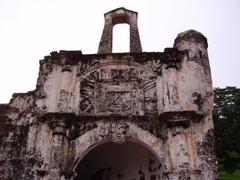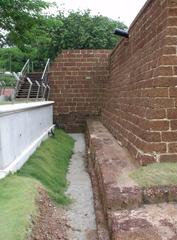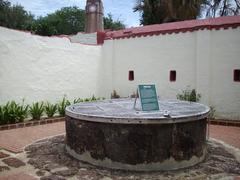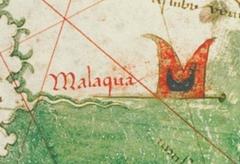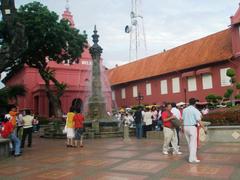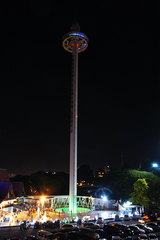Governor’s Museum Tanjung Kling: Visiting Hours, Tickets, and Travel Guide
Date: 04/07/2025
Introduction to the Governor’s Museum in Tanjung Kling
Nestled along Malacca’s storied coastline, Tanjung Kling and the Governor’s Museum stand as enduring monuments to Malaysia’s maritime significance and colonial legacy. Once a vibrant trading post during the Malacca Sultanate, Tanjung Kling draws its name from the Indian trader community that helped shape its multicultural heritage (Sayang Melaka). Its location along the Straits of Malacca ensured its continuing relevance as a nexus of commerce and cultural exchange.
The Governor’s Museum, perched atop St. Paul’s Hill, offers a unique perspective on the evolution of governance in Malacca. The structure, a former Dutch governor’s residence and later the official home of the Yang di-Pertua Negeri (Governor) of Melaka, is now a museum featuring artifacts, ceremonial regalia, and historical documents that chart Malacca’s political journey (Wikipedia).
The site’s Maritime Museum component—including the iconic Flor de la Mar replica—immerses visitors in the rich seafaring history of the region, highlighting pivotal moments from the Age of Exploration and the role of indigenous maritime traditions (audiala.com). This guide provides everything you need, from practical visitor information to historical context, ensuring an enriching experience for history buffs, families, and cultural explorers alike (perzim.gov.my).
Table of Contents
- Historical Evolution of Tanjung Kling
- The Governor’s Museum: A Colonial Legacy Reimagined
- Governor’s Museum (Maritime Museum) in Melaka
- Governor’s Museum Melaka: Visiting Details & Insights
- Governor’s Museum Melaka Visitor Guide
- Summary and Final Tips
- References
Historical Evolution of Tanjung Kling
Early Origins and Etymology
Tanjung Kling’s history dates back to the Malacca Sultanate, when it was a crucial hub for traders from across Asia. Its name—“tanjung” (cape) and “Kling” (referring to Indian traders)—reflects the area’s early demographic makeup and its prominence in maritime commerce (Sayang Melaka). Portuguese explorers in the 16th century, upon observing Indian workers at the cape, solidified the name “Tanjung Kling.”
Role in the Malacca Sultanate
At its zenith, Tanjung Kling served as both a commercial center and a royal retreat, with Bukit Banglo providing a strategic and scenic vantage point. The area’s two major ports facilitated the exchange of goods including spices, textiles, and ceramics, underscoring its role as a maritime gateway (Sayang Melaka).
Colonial Transformations
The Portuguese conquest in 1511 marked the start of a new era, with Tanjung Kling maintaining its importance. Under Dutch rule, the administrative landscape evolved, with Dutch officials constructing residences atop hills like St. Paul’s Hill (idbackpacker.com). The British period brought new waves of migrants, further enriching the area’s multicultural fabric.
Modern Era and Cultural Significance
Today, Tanjung Kling celebrates its Tamil heritage, with local festivals, cuisine, and religious sites. Its beaches and coastal villages offer recreational opportunities, making it a popular destination for those seeking both history and leisure (idbackpacker.com).
The Governor’s Museum: A Colonial Legacy Reimagined
Architectural and Historical Background
The Governor’s Museum, or Muzium Yang di-Pertua Negeri Melaka, sits atop St. Paul’s Hill. Originally a Dutch colonial residence and later the Governor’s official home, the building exemplifies colonial architecture with robust masonry and broad verandas, ensuring comfort and a commanding view of the city (Wikipedia).
Transition to a Museum
The residence was converted to a museum in 2002 after serving as the Governor’s home until 1996. This transformation preserved an important slice of Malacca’s colonial heritage (Wikipedia).
Exhibits and Collections
Visitors can explore personal belongings of past governors, official documents, ceremonial regalia, and multicultural gifts. The original rooms—reception halls, quarters, and offices—offer an immersive experience.
Visiting Hours and Tickets
- Hours: Generally 9:00 AM – 5:00 PM daily; check official sources for updates.
- Tickets: Standard admission applies, with discounts for children, students, and seniors.
Accessibility and Tips
- The ascent up St. Paul’s Hill may be challenging; wear comfortable shoes and sun protection.
- Photography is allowed in most areas, but check for restrictions.
- Combine your visit with nearby sites: St. Paul’s Church, The Stadthuys, and Melaka Sultanate Palace Museum.
Governor’s Museum (Maritime Museum) in Melaka
Maritime Heritage and the Straits of Malacca
Located along one of the world’s busiest shipping lanes, the Maritime Museum highlights Melaka’s pivotal maritime role (audiala.com).
Colonial Encounters and the Age of Exploration
Exhibits detail the Portuguese conquest, Dutch and British colonial periods, and the spice trade. The Flor de la Mar replica is a standout, offering a tangible link to the era (audiala.com).
Preservation of Local Traditions
Displays celebrate local boat-building, fishing techniques, and coastal community heritage (audiala.com).
Educational and Community Engagement
Interactive exhibits, workshops, and oral history projects foster community participation and lifelong learning (audiala.com).
Architectural and Experiential Highlights
The Flor de la Mar replica spans 34 meters and features seven decks for exploration (attractionsinmalaysia.com). The museum is fully wheelchair accessible, with ramps, elevators, and accessible restrooms (audiala.com).
Practical Information
- Hours: 9:00 AM – 6:00 PM daily (confirm on official site).
- Tickets: RM10 (adults), RM5 (children 6–12), free under 6. Discounts for groups and educational visits.
- Location: 12 km north of Melaka City; accessible by bus, taxi, or car.
- Facilities: Wheelchair access, restrooms, parking, and a gift shop.
Economic and Symbolic Significance
The museum supports local businesses and promotes intercultural understanding, making it a symbol of Malaysia’s maritime and multicultural heritage (audiala.com).
Governor’s Museum Melaka: Visiting Details & Insights
Setting and Atmosphere
The museum, in a Dutch colonial mansion surrounded by gardens, is part of the Stadthuys Museum complex. It offers a tranquil setting and insight into Melaka’s administrative history (Melaka Tourism Board).
Hours & Tickets
- Open: Daily 9:00 AM – 5:00 PM (closed Mondays/public holidays; check for changes).
- Fee: Entry is included in the Stadthuys Museum complex pass (approx. RM 20/adult in 2025).
Exhibits
- Ground Floor: Reception halls and living spaces with period furnishings.
- Upper Floor: Diplomatic gifts, personal memorabilia, and a portrait gallery of past Governors.
Accessibility
Partial accessibility; stairs between floors, but ramps/assistance may be available. Location is walkable within the heritage district.
Visitor Tips
- Visit early or late for fewer crowds.
- Dress modestly.
- Allow 30–60 minutes for your visit.
- Download the Audiala app for self-guided tours.
Governor’s Museum Melaka Visitor Guide
Location
Situated in Tanjung Kling, about 12 km northwest of Melaka’s city center (TravelTriangle). Reachable by car/taxi or public bus (limited schedules). From Kuala Lumpur, travel via express bus to Melaka Sentral, then taxi or Grab (Wanderlust Magazine).
Hours & Tickets
- Open: Tuesday–Sunday, 9:00 AM–5:00 PM; closed Mondays/public holidays (perzim.gov.my).
- Admission: RM 5 (adults), RM 2–3 (children/students/seniors), with discounts for Malaysians and groups.
Facilities
- Ramps available; some upper floors may only be accessible by stairs.
- Restrooms, shaded gardens, gift shop, free parking (limited on weekends).
Highlights
- State rooms, artifacts, documents, and temporary exhibitions.
- Photography allowed in most areas (no flash/tripods where prohibited).
Guided Tours
Available on request; advance booking recommended for groups or non-Malay/English tours.
Best Times to Visit
Mornings/late afternoons during weekdays and dry season (March–October) offer comfortable conditions (Wanderlust Magazine).
Nearby Attractions
Puteri Beach, Hang Tuah Mausoleum, seafood restaurants, and Melaka’s UNESCO-listed sites (TravelTriangle).
Etiquette & Safety
Dress modestly and behave respectfully. The museum follows health protocols and provides assistance in emergencies.
Summary and Final Tips
Tanjung Kling and the Governor’s Museum together offer a profound journey through Malaysia’s maritime and colonial heritage, from vibrant trading port to colonial residence and modern museum (Sayang Melaka; Wikipedia). With diverse exhibits, accessible facilities, and proximity to other heritage sites, they provide an enriching experience for all visitors (audiala.com; perzim.gov.my).
To make the most of your visit:
- Check current hours and ticketing.
- Consider a weekday visit for a quieter experience.
- Take advantage of guided tours and educational workshops.
- Download the Audiala app for updates and self-guided tours.
Start your journey into Malacca’s vibrant history and discover why the Governor’s Museum is a must-visit destination for travelers and history enthusiasts alike (audiala.com; perzim.gov.my).
References
- Sayang Melaka - History of Tanjung Kling
- Audiala - Maritime Museum in Tanjung Kling
- Melaka Tourism Board
- Melaka Museums Corporation (PERZIM)
- Wikipedia - Governor’s Museum
- TravelTriangle - Places to Visit in Malacca
- Wanderlust Magazine - Melaka World Heritage Travel
- Attractions in Malaysia - Maritime Museum
